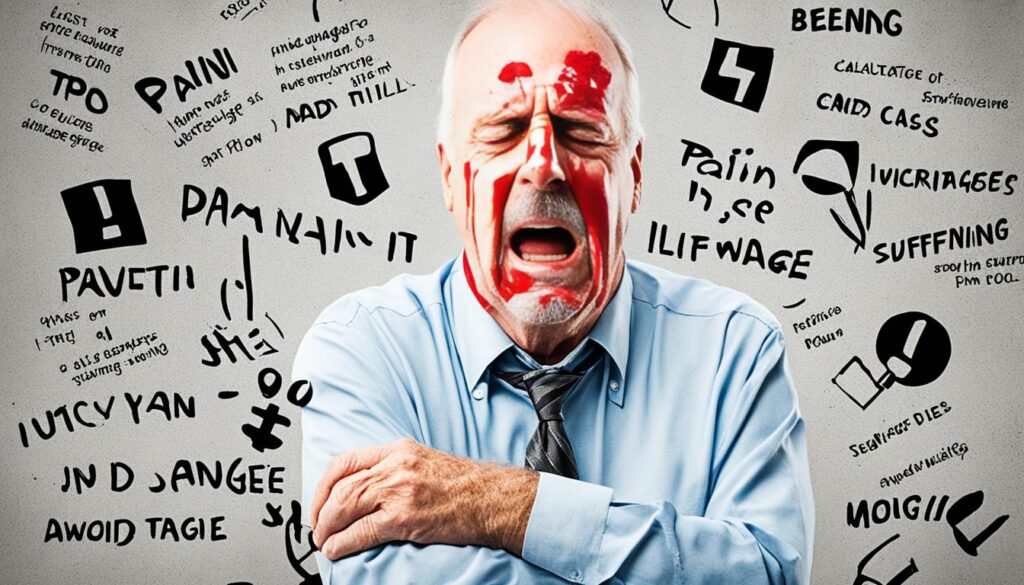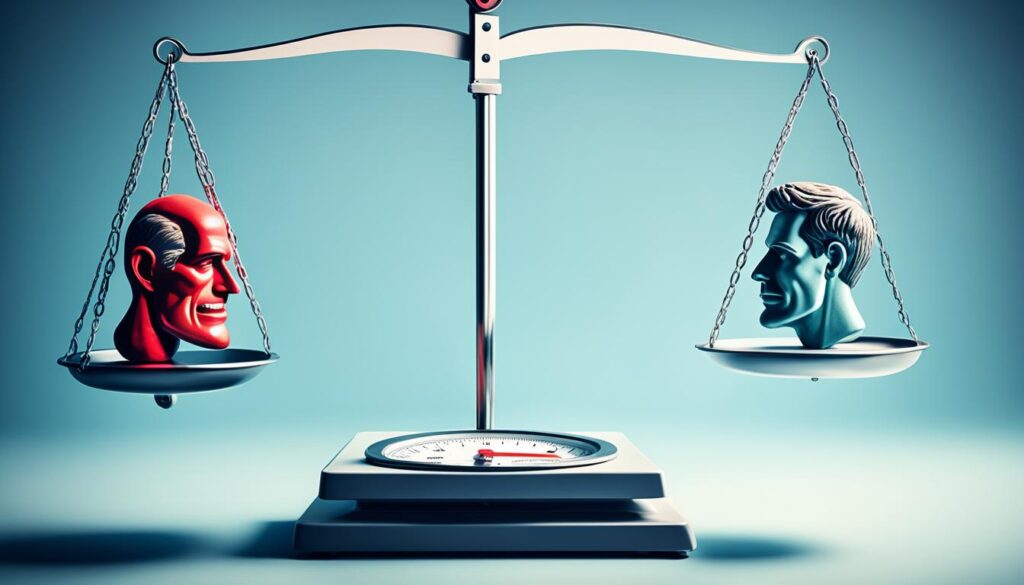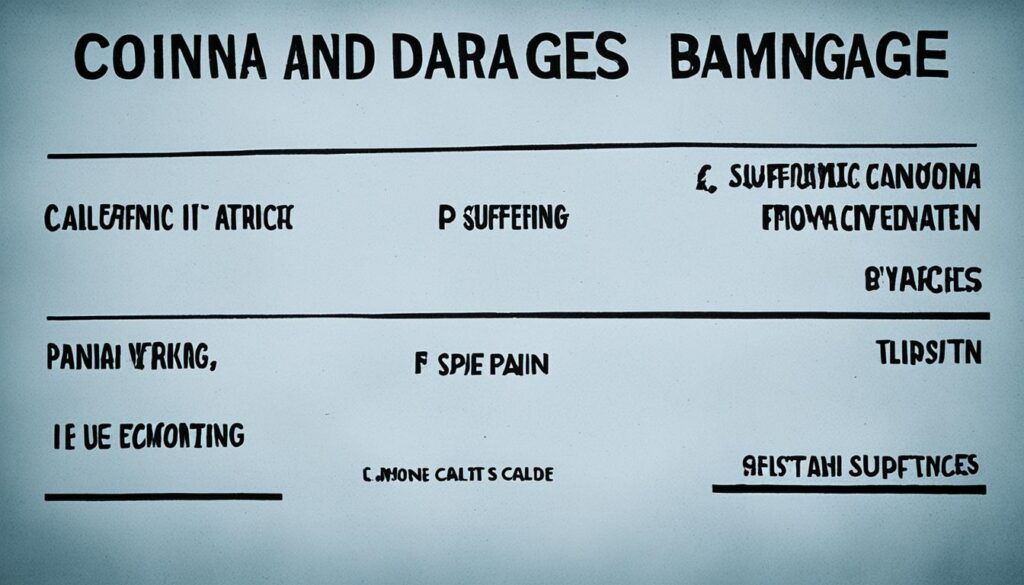Are you familiar with pain and suffering damages in personal injury cases? It’s crucial to understand how these damages are calculated. Also, knowing how to prove them is essential. This will ensure you’re not settling for less compensation than you deserve. Let’s explore the methods for calculating and proving pain and suffering damages.

Key Takeaways:
- Pain and suffering damages are a significant component of personal injury claims, comprising more than half of the total award.
- These damages encompass both physical and emotional distress caused by the injuries.
- Proving the amount of pain and suffering in a personal injury claim requires evidence such as medical records, expert testimony, pain journals, and witness testimony.
- Calculating pain and suffering damages can be done through methods such as the multiplier method and the per diem method.
- California places limitations on pain and suffering damages in some cases, such as workers’ compensation and medical malpractice, while there are no such limits in general personal injury cases.
What is Pain and Suffering and How Does It Apply to Personal Injury Cases?
Pain and suffering refers to the physical and emotional stress from an injury. This stress comes from someone else’s careless actions or intentional harm. In personal injury cases, victims seek compensation for these non-monetary losses.
These damages include the physical pain and emotional troubles the victim faces. This can be mental distress, emotional trauma, anxiety, depression, and not enjoying life as before. It’s key to understand that these damages are separate from medical bills, car repairs, or lost income. They focus on the victim’s intangible losses due to the injury.
Types of Pain and Suffering Damages in Personal Injury Cases
In personal injury cases, there are two types of pain and suffering damages. These are physical pain and suffering and emotional pain and suffering.
Physical Pain and Suffering
Physical pain and suffering is about the body’s distress caused by an injury. It includes many symptoms and effects:
- Long-term disability: Some injuries lead to long-lasting or permanent disabilities. This affects how well the body moves and functions.
- Anticipated limitations to physical abilities: Victims might face limits in what their bodies can do. For example, they might find walking or doing certain tasks hard.
- Complications in daily routines: Injuries can change how daily activities are done. Simple tasks might become hard or impossible.
- Persistent physical discomfort: Ongoing pain, discomfort, and physical limits can come from the injuries.
- Significant disfigurements: Some injuries change how a person looks. This can affect their self-esteem and life quality.
- Loss of bodily function: Serious injuries might stop certain body functions. This includes walking, seeing, or using limbs.
Emotional Pain and Suffering
Emotional pain and suffering are about mental and emotional distress from the injury. Victims might face various emotional problems:
- Feelings of depression and anxiety: Injuries can cause sadness, hopelessness, and worry.
- Post-Traumatic Stress Disorder (PTSD): Some victims get PTSD. They might have flashbacks, nightmares, and a lot of anxiety.
- Disturbed sleeping and eating patterns: The mental stress from an injury can change sleeping and eating habits. This can lead to more health issues.
- Loss of pleasure in activities: Victims might not enjoy their favorite activities anymore because of the emotional pain.
- Unpredictable mood swings: This emotional pain can cause mood changes. It’s hard for victims to stay emotionally stable.
- Overwhelming fear, anger, or humiliation: Injuries can bring strong emotions like fear, anger, or shame. This affects mental health and well-being.
Both types of pain and suffering greatly affect a victim’s well-being and life quality. These damages are key when asking for compensation in personal injury cases.
Establishing the Link Between Injuries and Pain and Suffering
In personal injury cases, linking injuries to pain and suffering is vital. Pain and suffering come from many sources. These include the injury’s pain, pain from treatments, ongoing pain, and mental worries about the future.
For victims to get compensated, proving this link is crucial. They must show evidence like medical records and expert views. This proves the connection between injuries and the pain felt.
Causes of Pain and Suffering
The pain can come straight from the injury. This might be acute pain, long-lasting pain, or trouble doing daily tasks.
Medical treatments can also cause pain. For example, surgery to fix a broken bone may bring pain during healing.
Some injuries lead to chronic pain. This long-term pain affects the victim’s life and future.
Mental anguish is part of pain and suffering too. It includes anxiety, depression, and PTSD. These are due to the physical pain and its effects.
Proving the Link
Different types of evidence can show the link between injuries and pain:
- Medical records are vital. They show the injuries, pain, and treatments. This helps prove the link between injuries and suffering.
- Experts in medicine can explain how injuries cause pain. Their knowledge helps support the victim’s case.
- Psychological evaluations reveal how injuries affect mental health. They are key in showing the link to pain and suffering.
- Witnesses who saw the victim’s struggles can testify. Their stories support the link between injuries and suffering.
By using strong evidence, victims can prove the link. Then, they can seek the compensation they deserve.
Calculating Pain and Suffering Damages in Personal Injury Cases
To figure out how much money should be given for pain and suffering in personal injury cases, several methods are used. Two main ways are the multiplier method and the per diem method.
The Multiplier Method
The multiplier method takes the cost of your economic losses, like medical bills and lost salary, and multiplies them. This helps find the amount for pain and suffering. The number we multiply by varies based on a few important details:
- The severity of the injury – Bigger injuries lead to higher numbers to multiply by.
- The expected duration and permanence of the pain and suffering – If the injury lasts a long time or is forever, the number goes up.
- The impact on daily life and emotional well-being – Injuries that heavily alter your daily life or hurt emotionally increase the multiplier.
The Per Diem Method
With the per diem method, a daily value is given to the pain and suffering. Then, this value is multiplied by the days you’ll likely hurt. The total can change based on a few things, like any lasting effects, how long it takes to get better, if the claims are consistent, and any past crimes.
Choosing the correct method to figure out pain and suffering payment depends on the case’s unique details. It’s crucial to understand how bad the injuries are and their effect. Also, having strong evidence is important. Talking to a skilled personal injury lawyer can help make sure the amount is right and fair.

| Method | Key Factors |
|---|---|
| Multiplier Method | Severity of the injury |
| Per Diem Method | Duration and permanence of the pain and suffering |
| Impact on daily life and emotional well-being |
Finding the value for pain and suffering damages is tough. It needs a lot of thought about the injuries and their effects. Getting help from legal experts is key. They can handle the complex parts of personal injury cases. This ensures victims get the right amount for their pain and suffering.
Proving Pain and Suffering in Personal Injury Claims
To prove pain and suffering in a personal injury case, you need strong evidence. This includes medical records for the injuries and pain, expert testimony to explain the pain’s extent, and witness testimony to share changes seen in the victim. Victims can also keep a pain journal and give personal testimony.
Medical records are key for showing the victim’s pain and suffering. They are real proof of the injuries and treatment. These records link the injuries directly to the pain felt.
Expert testimony from doctors brings trustworthiness to the claim. Experts outline how the injuries affect the victim now and later. Their knowledge proves the claim is true.
“The medical records and expert testimony were instrumental in proving the intensity and duration of my client’s pain and suffering. The jury could see the concrete evidence and understand the long-term impact it had on her daily life.” – Attorney James Thompson
Testimony from people who saw the victim’s changes is moving. They can speak on how the victim’s life is different now. Their stories are a direct peek into the victim’s daily pain.
A pain journal helps document every day pain and suffering. This lets the victim note how their pain changes day to day. It offers solid proof for their case, showing the pain’s timeline.
“The pain journal maintained by my client was crucial in proving the ongoing nature of her pain and suffering. Each entry provided valuable insight into the daily challenges she faced and how it affected her quality of life.” – Attorney Sarah Rodriguez
The victim sharing their story adds a personal touch. It lets the jury feel the pain from the victim’s view. This personal account is central to understanding the injury’s impact.
Collecting detailed evidence like medical records and personal stories builds a strong claim. Each piece is key to showing the truth of the pain and suffering. This evidence is essential for getting the right compensation in a personal injury claim.

Limitations on Pain and Suffering Damages in California
In California, victims’ compensation for pain and suffering has limits. These limits are in cases like workers’ compensation, medical malpractice, and insurance coverage issues. It’s key to know these limits and their impact on your claim.
1. Workers’ Compensation Cases
Workers’ compensation cases do not offer pain and suffering damages. The focus is more on medical care and covering lost wages for injured workers. So, you can get money for medical bills and missed work. But, you can’t get extra for pain and suffering.
2. Medical Malpractice Cases
There’s a cap on what you can get for pain and suffering in medical malpractice cases. In California, this cap is $250,000. Even with severe pain from malpractice, $250,000 is the most you can receive for these damages.
3. Insurance Coverage Limitations
Looking for high compensation for pain and suffering? Think about the defendant’s insurance and money situation. If they lack adequate coverage or funds, getting your full pain and suffering damages might be hard.
Talking to a skilled personal injury lawyer is crucial. They’ll explain how these limits affect you. And they’ll assist in seeking the most money possible for your pain and suffering.

The Importance of Seeking Legal Representation for Pain and Suffering Claims
Having legal help for pain and suffering claims in injury cases is key. An experienced injury lawyer guides you and fights for your rights. They help ensure you get the most for your pain and damages.
An expert injury lawyer knows how to value your claim. They collect evidence, like medical records and witness accounts. This builds a strong case for you.
Insurance companies may try to pay you less than you deserve. But a skilled lawyer can handle the talks for you. They know the insurance companies’ tactics. This way, they help you get the best compensation for your pain and suffering.
Sometimes, pain and suffering disputes go to court. That’s when legal representation is crucial. Your lawyer will stand up for you in court. They ensure your story is told to the judge and jury.
When You Have Legal Representation, You Increase your Chances of:
- Receiving fair compensation for your damages
- Having a pro who knows personal injury law on your side
- Avoiding mistakes that could harm your claim
- Getting help and support all through the legal process
Seeking a lawyer means aiming for fair compensation for your suffering. With their expertise, a personal injury lawyer guides you to a positive result.
If you’re hurt from an accident, see an injury lawyer. They’ll defend your rights, get you the right compensation, and give you peace of mind. This lets you focus on getting better.
Always remember, “A skilled injury lawyer really increases your compensation for pain and suffering.”

| Benefits of Seeking Legal Representation for Pain and Suffering Claims |
|---|
| An experienced personal injury lawyer can assess the value of your claim accurately. |
| They will gather all the necessary evidence to support your pain and suffering damages. |
| Your lawyer will negotiate with insurance companies to maximize compensation. |
| If necessary, they will represent you in court and present a strong case. |
| You increase your chances of receiving fair and just compensation. |
| A lawyer understands the intricacies of personal injury law and can guide you through the legal process. |
| They can help you avoid costly mistakes that could jeopardize your claim. |
| Your lawyer provides guidance and support throughout the entire process. |
Real-Life Examples of Pain and Suffering Damages
Real-life stories can teach us a lot about damages in personal injury cases. These stories show how physical and emotional distress affects victims and families.
A Construction Worker’s Struggle
A construction worker, Alex, got badly hurt on the job. This injury made Alex feel a lot of physical pain and problems. Tasks became hard, and Alex couldn’t move like before.
The damages asked for in court cover these severe effects on Alex’s life and happiness.
A Family’s Heartbreak
In another sad story, a family lost someone they loved in a car crash. The family’s heartache and grief were overwhelming. They felt lost without their loved one.
This emotional hurt hurt their mental health and life quality. The family sought damages for these deep emotional wounds, hoping for some justice.
These stories help us understand pain and suffering in personal injury cases. They show the deep physical and emotional pain victims face. Seeking fair compensation is crucial for supporting these victims and their families.

Comparing Physical and Emotional Pain and Suffering Damages
| Physical Pain and Suffering | Emotional Pain and Suffering |
|---|---|
| Ongoing physical discomfort and disability | Grief and loss of companionship |
| Significant limitations in daily life | Emotional trauma and distress |
| Physical disfigurements and loss of bodily function | Loss of pleasure in activities |
This table outlines how physical and emotional damages differ. These damages pose unique challenges for victims wanting fair compensation. Recognizing the different types of pain helps us better support these victims.
How California Law Protects Victims Seeking Compensation for Pain and Suffering
California’s laws help victims get money for pain and suffering in injury cases. For worker’s comp and medical cases, there are limits. But for other personal injuries, there’s no cap. This means people can seek fair money for their physical and emotional pain.
The Medical Injury Compensation Reform Act (MICRA) is important here. It limits money for medical mistakes but not other injuries. So, in other cases, there are no limits on money for pain and suffering.
Not having a cap lets victims ask for full compensation. Pain and suffering damages are often a big part of these awards. They help cover the victims’ physical and emotional struggles caused by others.
California aims to treat victims fairly by allowing them to ask for pain and suffering compensation. This helps victims recover from their injuries’ physical, emotional, and financial tolls.
Conclusion
Pain and suffering damages are key in personal injury cases. They offer money for the hurt and stress victims feel. These damages often form a large part of the total money given. Yet, showing how deep this pain goes needs strong evidence.
The multiplier method and the per diem method help figure out these damages. They look at how serious the pain is. And how it changes the victim’s life. It’s vital to have a lawyer to get the most money and a fair deal.
California has rules to protect those hurt and looking for money for their pain. Even with some limits, like in workers’ comp and medical mistakes, there’s no max money for pain in most cases. Knowing these rules and how to show your pain in California is important. It helps victims get the money they rightly deserve.
To prove pain, you might need medical records and expert’s words. Also, witness stories, pain journals, and your own story can help. With a good lawyer, you can better handle this tricky part. You have a higher chance of getting fair money for your pain and suffering.
Each case is different, making talking to a lawyer critical. They can guide you on the best steps and choices for your case. This way, you can aim for the right compensation for your injuries and pain.